Maysha Mohamedi
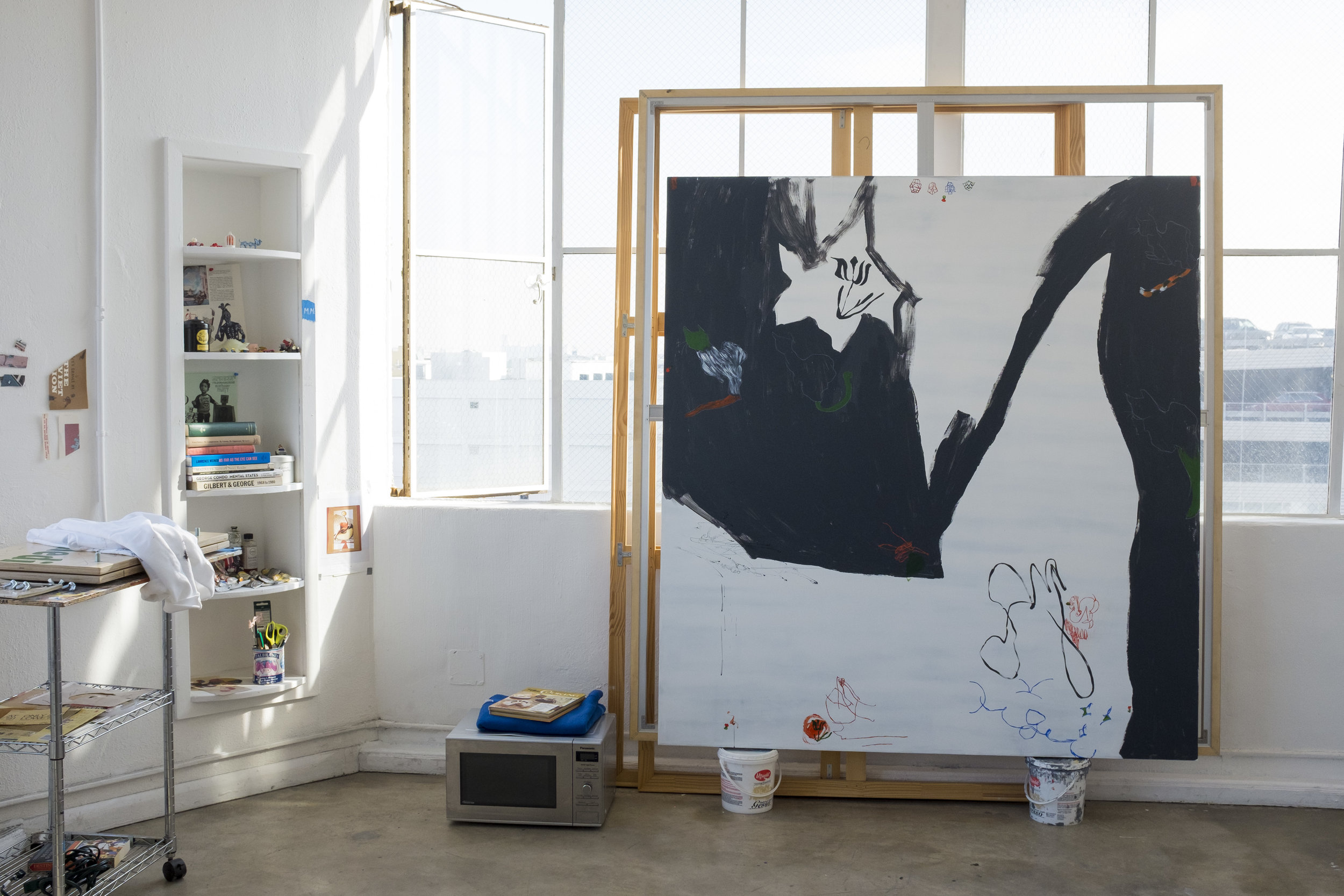
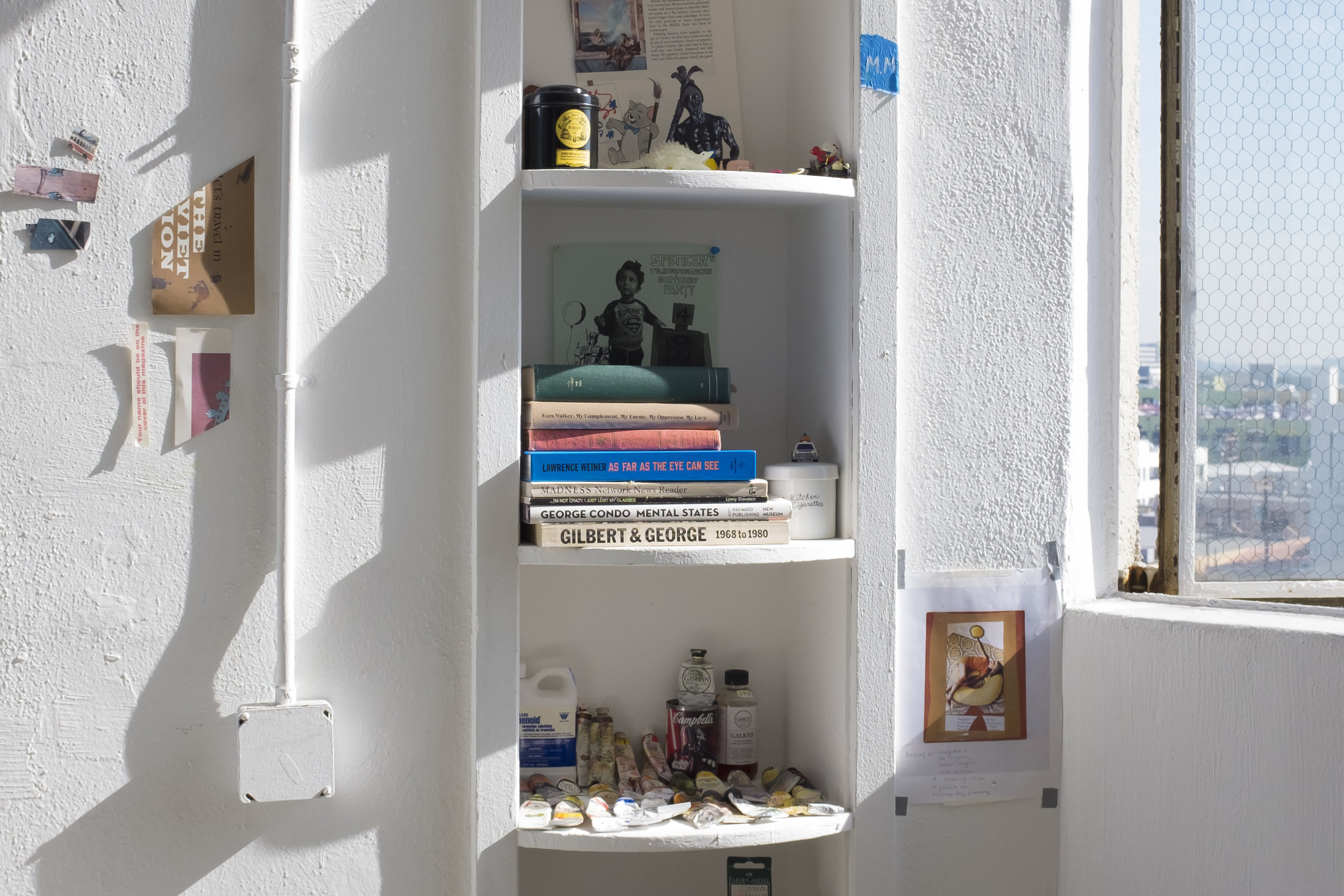
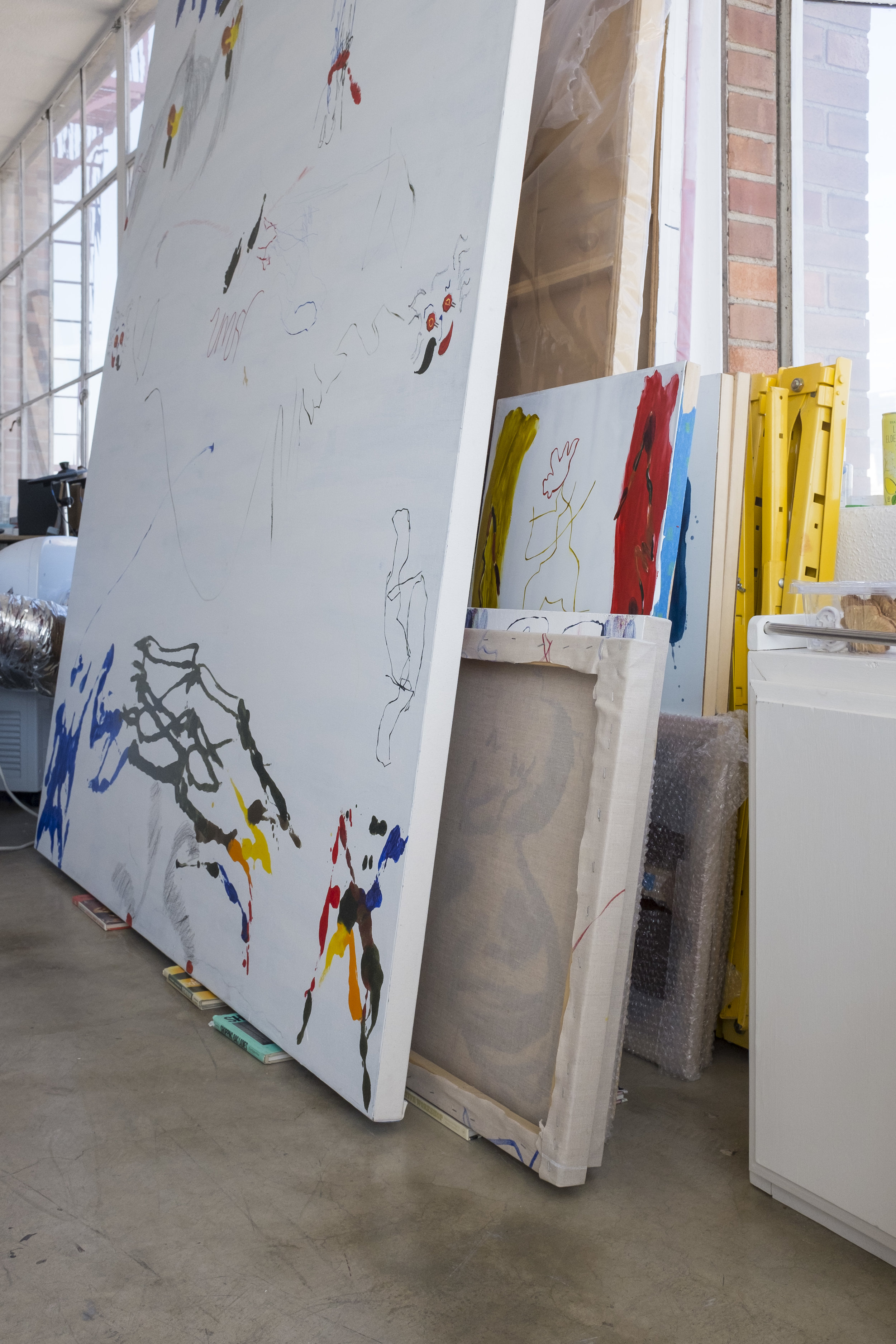
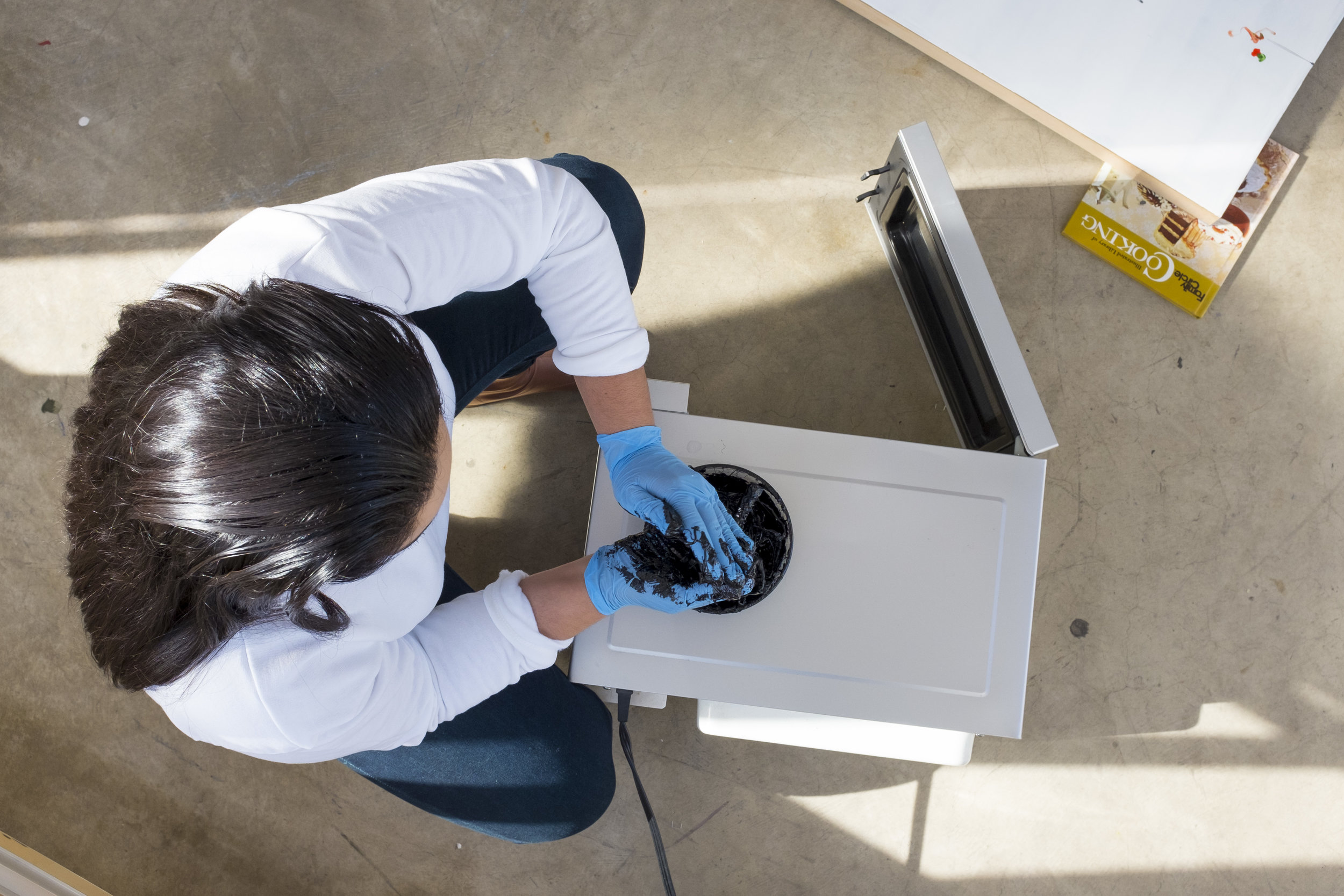
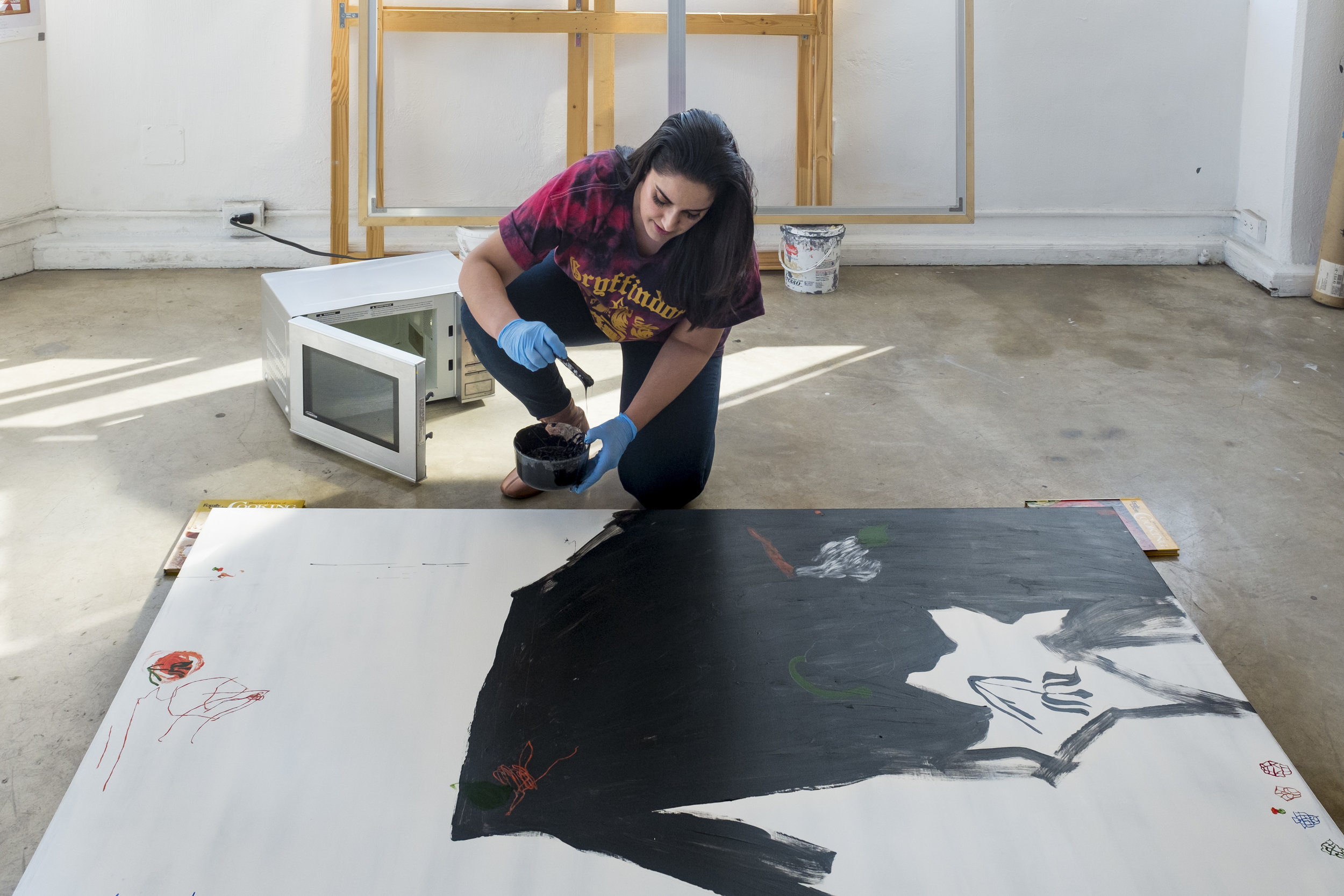

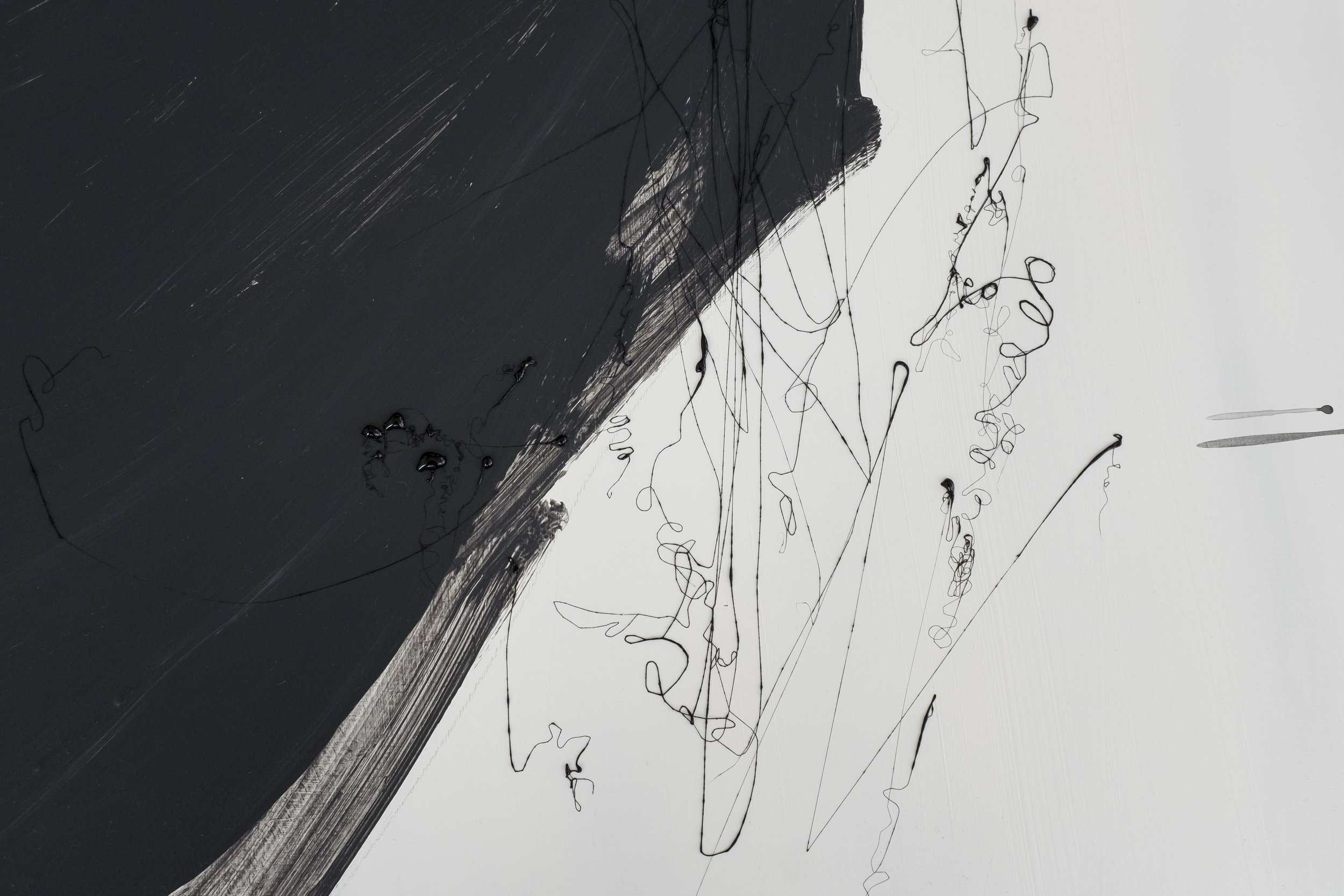

Maysha Mohamedi
Who are you?
I am Maysha Mohamedi.
What do you make?
I make paintings and sculptures and party invitations for my kids—all sorts of things.
Do you have a preferred medium?
Painting. Up until now I've mainly used oil paint, but I'm starting to use more materials that are handy like pencils, crayons, and acrylic paint; anything that's easy to apply and dries quickly.
Describe your workspace.
My studio is located in the Bendix Building in the Fashion District of Downtown Los Angeles. It's a southeast facing corner studio with ten windows. It's super bright and has a lot of light, which is its outstanding feature. I can also see the downtown LA skyline.
Under what conditions do you work best?
I can't really work in clutter, so I always make a lot of floor space available so that I can lie my paintings down and work on them horizontally on the floor. I don't like to look at a lot of excess visual details that aren't related to the actual painting that I'm working on at a given moment. I prefer working in the morning and natural light. I like music and fresh air. I guess it's also important to have enough water and food so I don't have to think about that.
Do you have any rituals surrounding your practice?
I'm a very ritualistic person and I can really luxuriate in that process, however since I've had children that's sort of been the first thing to go because every minute of my time has to go toward productivity. That being said, I think a lot of my ritualistic tendencies are now captured in my thought process, because that's the one thing that my children can't take away from me. I can still be thinking about things even if I'm giving a bath or making dinner or sustaining a tantrum. I think obsessively about a painting before I start it. If I know the dimensions of a painting I'm going to make and I know I'm going to make it in the next several weeks, I will think about the painting consciously and subconsciously for weeks prior to the first mark that I lay down on the surface. I let my brain obsessively do the work prior to the actual execution. That's the dominating ritual that I’ve harnessed since my time has become so compromised with children. I think my rituals primarily happen outside of the studio because I’ve had to learn to execute as soon as I step inside of it. The studio is not a space for me to be footloose and fancy free, unless that has to do with actual paint application.
Describe your creative process.
My creative process is when I'm thinking about a painting and investing it with an idea or ideas. I've tried not to control that very much because I want to make paintings that feel very true. I think I can do that if I don't control the inception of the idea very much. I'm sort of like a semipermeable membrane; I just look at what's around me, watch the thoughts that I have, listen to my children, listen to the air. I'm this filter for whatever's happening around me. I'll start to lock onto these concepts that pass through me and I know that they're what I will imbue the painting with. I think part of becoming a more sophisticated artist is being able to more quickly lock onto the things that matter in a painting that's about to happen.
Describe your creation process.
When I get to the studio and I start a painting, it doesn't really have to be related to those concepts. I just need the first marks to come with a deep meaning, and then the painting will be set on its course. And that, in my experience, has been the way that I can transmit a truthful painting. Once I'm executing the painting, the choices become more and more formal as time goes on. Frequency of mark making is important to me; I start to slow down as my decisions become more formal because I can feel the end of a painting coming closer and I know that it's maybe five to ten marks away from being finished. I move slower to make sure that those marks are the ones that need to happen.
What is mark making for you?
That word means a lot for me because I'm not the type of painter who sits at an easel and uses brushes and a classical method of mixing paint and medium. The idea of painting—that word—never seemed to reflect what I was doing. I collect found objects like a little toy and I dip the head of the toy in paint and make a mark across the surface, or I make homemade stamps out of pieces of cardboard, or I find a pencil that my son just used and I know that its saturated with his goodness and believe that the mark I make after he used it will be excellent. So mark making as a descriptive term seems more applicable to me than painting.
How do you choose and source your materials?
I am open to anything coming into my world, so it could be anything, really. I used to be more deliberate about seeking things out. When I lived in San Francisco I had this very detailed map of all the best thrift stores and junkyards all the way up to Napa. Once every couple of months I would go on these expeditions and hunts by myself and collect things. That was a way for me to find myself in the world without the pressure of having to invent something out of thin air that I felt reflected myself. It was like a grand, world-size game of Hidden Pictures. I wouldn’t quite know what I was looking for, but I knew it when I saw it. And sometimes I wouldn’t even know why I was drawn to a thing. But that process helped me define what it is that I am actually attracted to and drawn to. So now when I see something I like I can pretty much identify why, which maybe I couldn’t five years ago. But now I don't do that so much; I don't really like clutter and that was a big problem with that method. Objects weigh me down. I don't like to have a lot of things around me because I want the ideas and energy within myself to dominate the room and dominate the work.
What’s the relationship between the support and the surface of your paintings?
That relationship is really important to me, but I've had to let go of it. I love super hard, heavy surfaces, so my ideal surface would be a masonite panel because it’s super smooth and has a dark brown tone. It can't be true, but when they're first delivered they smell like pipe tobacco to me. It feels so easy to make a grand painting on such a surface, but I've had to let go of that because those kinds of surfaces are very expensive and they're very heavy. That has behooved me to move to canvas and linen because they're easier to move around both for myself and for collectors and galleries. The thing about the panel is that it feels like a one-shot deal. I enjoy the performative aspect, like I've got one shot to make this painting otherwise it goes to hell. With stretcher bars, if you screw up the painting you can always unstretch it, throw it out, and redo it. Hopefully in another phase of my career I can order panels willy nilly and treat them like post-it notes, but right now I'm mainly doing stretcher bars and canvases, trying to ignore the fact that they're not my favorite surfaces. But I think it's good to try and make the best paintings you can make in nonideal circumstances, whether you have to paint in your bedroom or whether its on a surface that's not your favorite or whether you can't afford the best tube of paint. That’s good for the integrity of an artist, I think.
Does critique play a role in your process?
Not really. I feel like I’m at this level where critique is not the right word. I’m not inviting people in here to tell me what to do. I mean I never was that type of artist, but I think the phase within which that word would be appropriate has passed. I guess if it were somebody that I really really admire who was much more senior than I am, I would accept critique-esque words. But otherwise I’m not looking for that. When people come in here it's about sharing ideas. I do a lot of studio visits and exchanges of ideas; I’ll visit an artist and she’ll visit me. That's huge. But that's also half about my work and half about community.
What’s the process of titling your work?
Titles are really important to my work. I think they can be very important to abstract work because they're often the first entrypoint for a person and they bring the painting into a relatable realm. I love words and I don’t think I’m gifted at being a writer—otherwise I would love to have been a writer—so doing a title is my way of exploring my love of words and writing. Even though my work is abstract I think it has become more relatable so I don't put as much pressure on the titles and I like to have fun with them. While I'm making work I jot down notes of what I'm thinking. I generally like the title to be something melodic and lyrical that adds something to the work. I want the title to feel like something that somebody hasn’t read before because I think it’s easy to make a title that’s cliché. The title is an artwork too. It’s prose. It’s part of the art.
What’s the most challenging part of your process? Where do you find the most ease?
I think the most challenging part is the physical difficulty of managing the work: having to build a stretcher, lifting stretcher bars if I have them delivered, moving a huge roll of canvas around, stretching the canvas, taking a painting here or taking a painting there, arranging for people to pick up a painting. The physical labor part has become harder for me. I suffer from pretty massive sleep deprivation so I just don’t have the energy for that stuff. I feel like I don’t have enough time to deal with those details with love and care the way that I would like to. It’s just flat out taxing. I think most artists—and I've fallen prey to this as well—get dissuaded because of the difficulty of the careerist side of things. As one evolves as an artist, a huge part of it is figuring out how to manage chronic disappointment. I don't feel that it's actually chronic disappointment, but if you go down a certain way of thinking it's easy to feel that it is. I think that's the number one trap and challenge of being an artist. But I do feel really lucky because the rest of my process does come easy for me. I just love it. I have a compulsion to express myself, and everything around that process is joy for me.
Does working in Los Angeles have an influence on your practice?
It does. There’s an artist community here that is really lovely. They’re full of love and kindness. I’ve met so many great people and that makes me a better artist; it makes me feel like I have something to offer because people care. That’s been huge in order for me to bring a sense of lightness and optimism to my work. When I lived in the Bay Area, the aesthetic that was most celebrated—even though there's a wonderful variety of artists there—was a monochromatic, black and white aesthetic. I’m not a black and white painter, but there I felt this pressure to make my color spectrum more digestible through that sort of lens. I think my colors had a very narrow range because I wanted to fit in. But here I don't feel that kind of pressure; I feel like I can be bombastic with color if I want, but I don't have to be. There's also more light around here so I’m sure that affects me as well.
Is there anyone or anything that inspires you?
Oh. Well, everything. I’m inspired by the things my children say, I’m inspired by my husband, my parents, my heritage, visiting other artist's studios and seeing the way they do things, watching somebody hold a pencil in an unusual way and the way they press it onto a surface. That inspires me because I think, Why not? Why can't I try that? Everything inspires me. I’m a sponge and a filter.
How have you learned what you know?
It's definitely related to my scientific foundation. I studied cognitive science in college, so a lot of what I learned in the laboratory is how I conduct my search in this world to find things that I want to paint about. I feel like I have an openness in the way that I approach my work that is reminiscent of how a scientist designs an experiment and tries things and fails and succeeds and evolves and progresses over time, maybe altering the experiment and tinkering with its pieces. That's very much a part of my practice. I also learned a lot from different art professors at CCA and in classes at SF State. All of the professors that I really connected with knew that I wasn't the type to geek out on art historical information. They were talented enough to present information to me in a way that I found interesting, which I am very grateful for now. I worked with Glen Helfand, Jordan Kantor, Linda Geary, Paul Mullins, James Gobel. I think all of these folks genuinely enjoyed talking to me and I enjoyed talking to them. They would often drop things by my studio or mention an artist to me in passing, not in the typical didactic way one would educate a student who's studying art, but because they knew I was a bit skittish about taking a deep dive into information. I so badly wanted to figure out how to make a painting that felt true to me. So I'm grateful for these teachers who sprinkled my education with just enough things that I needed to know. And I also learn things from everybody, I really do. Even animals.
In what ways has your practice evolved over time?
I think I’ve had two dominating forces that have pushed the evolution of my practice. One is how my time is allocated because I have a family and at times I also need to have a "regular job." So like I talked about earlier, that's changed how I come to the studio; I come in here and I just work. I don’t come here and daydream because I can’t really afford to do that. The other factor is my relationship to the careerist side of myself. I think there's always going to be a fluidity around how I feel I'm positioned in relationship to the art market—and by using the word art market I mean galleries, shows, collectors, all that stuff. There are times where I'm more focused on that and I'll post something on Instagram hoping that people come to a show or I'll share something about my practice that's important for people to know. And then there are times when I really need to just think about a painting. I think my comfort in passing through those different states of being is a big evolution that I've gone through. I think it's incredibly uncomfortable for artists to have the world looking at them. When you first put a painting out into the world, maybe five people are looking at it but it feels like it's out in the world and not with you anymore. Now I don't bat an eye at that; I make these things so that they are enjoyed by other people and not only myself. Now that I’ve done this long enough and I see all these changes, it’s exciting to think how things will be in ten or twenty years. I mean, maybe I'll have a five year period where I work on a film. A lot of artists do that. I might go through that. I don’t know, but that’s exciting. I don’t feel like I have a death grip on my fate anymore because I’m just open. I’m still surprised when I have epiphanies about my process. It's like I thought I knew everything about what I was doing, but I guess I don’t.
What has your practice taught you?
My practice has taught me something that my mom told me at my MFA show, which I have not fully inhabited believing until recently. It may be the one comment that she made. I mean she told me that my work was beautiful—obviously a mother would say that—but then she said something really unexpected. She was all teary eyed and she said, “You always have your thoughts. No matter what happens, you have your thoughts, and nobody can take that from you.” An MFA show has so much to do with the products, the pieces in front of you, that it kind of took me by surprise to hear something about my thoughts, something that I can't commodify as directly. I thought what she said was beautiful, but I didn’t really think about it too much until recently. It has taught me that the things that endure are ideas. That's one of the most important things in this world, especially right now when everything is about an image or a product or a tangible object or a reaction or an event. I think people forget about thoughts and ideas, which are the foundation for anything that’s important about us as humans. That was a big answer for your big question—there are a million other things too. But I will always have that no matter what.
How has your practice shaped your hands?
I love the residual stuff that ends up on my hands after the fact. I have a bit of a double life. I’m here as the master of my life and my studio, and then I go home where I’m a homemaker, a mother, a wife, and an office worker. I get a lot of joy when I'm sitting at a desk in an office, typing on a keyboard some totally stupid email with somebody who annoys the heck out of me, and I have a little fleck of paint on my wrist. That is my joy right there. It reminds me instantly of who I really am.
Maysha Mohamedi in Los Angeles, California on January 12, 2018. Photographs by Julia Girardoni.
